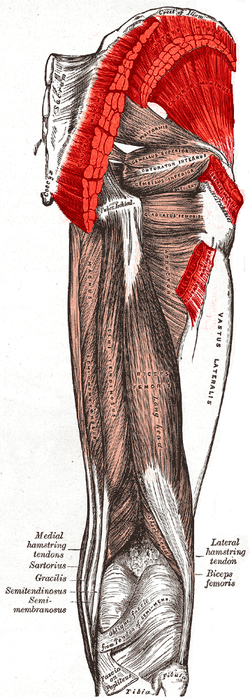Gluteal muscles
| Gluteal muscles | |
|---|---|

Muscles of the gluteal and posterior femoral regions. Gluteus minimus and the origins and insertions of medius and maximus labeled
|
|

Gluteus maximus
|
|
| Details | |
| Components | Gluteus maximus, medius and minimus |
| Artery | Superior and inferior gluteal arteries |
| Vein | Superior and inferior gluteal veins |
| Nerve | Superior and inferior gluteal nerves (L4, L5, S1 and S2 nerve roots) |
|
Anatomical terminology
[]
|
|
The gluteal muscles are a group of three muscles which make up the : the gluteus maximus, gluteus medius and gluteus minimus. The three muscles originate from the ilium and sacrum and insert on the femur. The functions of the muscles include , , external rotation and internal rotation of the hip joint.
The gluteus maximus is the largest and most of the three gluteal muscles. It makes up a large portion of the shape and appearance of the hips. It is a narrow and thick fleshy mass of a quadrilateral shape, and forms the prominence of the nates. The gluteus medius is a broad, thick, radiating muscle, situated on the outer surface of the pelvis. It lies profund to the gluteus maximus and its posterior third is covered by the gluteus maximus, its anterior two-thirds by the gluteal aponeurosis, which separates it from the superficial fascia and integument. The gluteus minimus is the smallest of the three gluteal muscles and is situated immediately beneath the gluteus medius.
The bulk of the gluteal muscle mass contributes only partially to shape of the buttocks. The other major contributing factor is that of the panniculus adiposus of the buttocks, which is very well developed in this area, and gives the buttock its characteristic rounded shape. Although the gluteal muscle bulk and tone can be improved with exercise, it is the disposition of the overlying panniculus adiposus which may be responsible for the "sagging butt" phenomenon. Exercise in general (not only of the gluteal muscles but of the body in general) which can contribute to fat loss can lead to reduction of mass in subcutaneal fat storage locations on the body which includes the panniculus, so for leaner and more active individuals, the glutes will more predominantly contribute to the shape than someone less active with a fattier composition. The degree of body fat stored in various locations such as the panniculus is dictated by genetic and hormonal profiles.
...
Wikipedia
